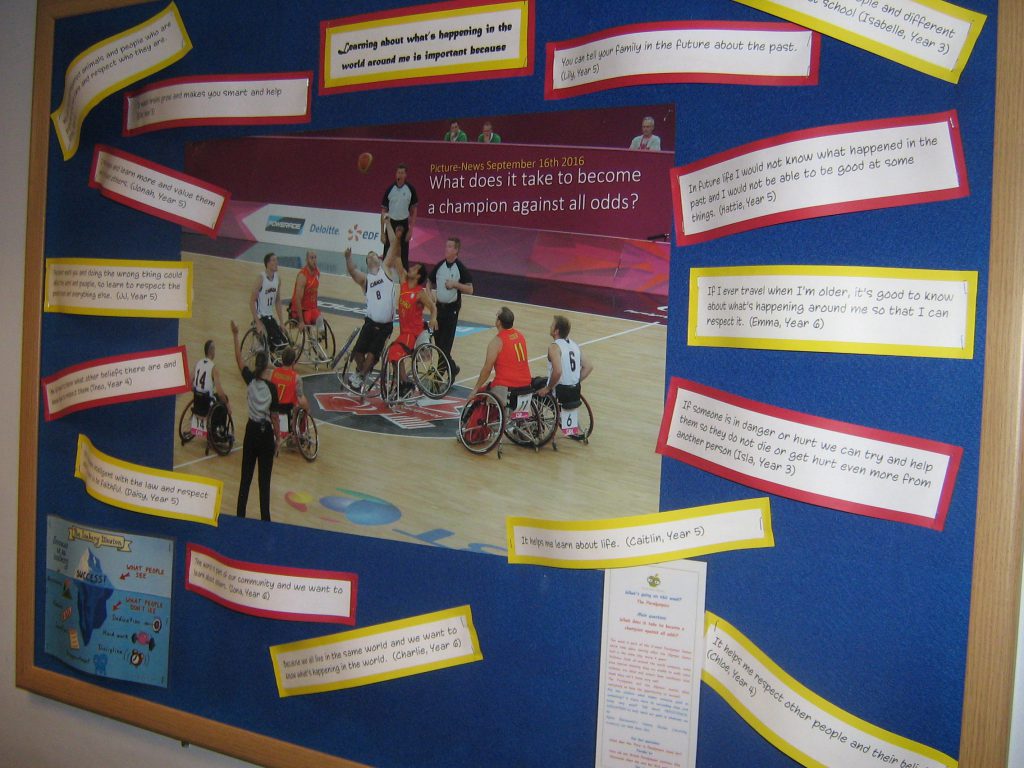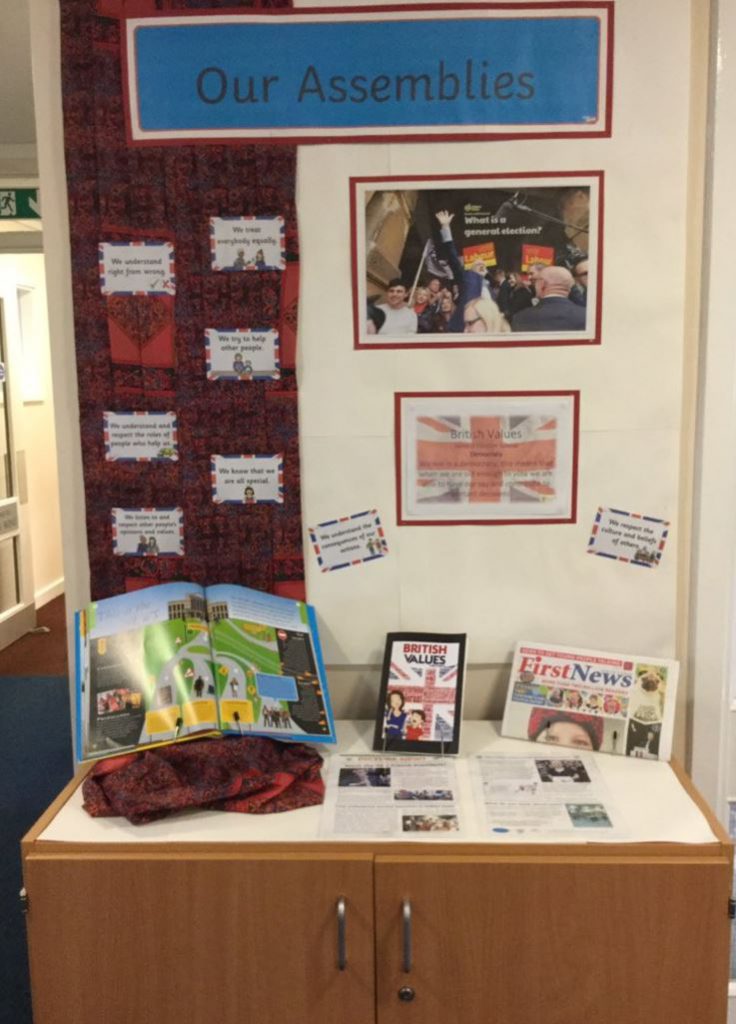Picture News – a resource for dialogic classrooms by John Dabell
Great News
It’s back to school and that means you will be getting your classroom ‘ready’ but what do you display?
How you design your classroom matters because this is the space that children will spend the majority of their time. Displays make a significant difference to the feel of a classroom and how children feel about themselves. There are a range of design factors that need careful consideration but displays play their part and what we display can affect how children think, behave and perform.
According to the report ‘Clever Classrooms’, undertaken by the University of Salford,
“Well-designed classrooms can boost learning progress in primary school pupils by 16%”.
Led by Professor Peter Barrett, the Salford research team offer some useful advice. They found that well-defined and age appropriate learning zones are important to facilitate learning and they recommend that displays should be planned to give “a lively sense to the classroom, but without becoming chaotic in feel. As a rule of thumb 20-50% of the available wall space should be kept clear.”
There will be plenty of subjects and projects vying for wall space and over the terms, displays will evolve and change in order to keep children engaged and interest levels high. Purposeful and well-planned work-oriented displays set the tone and create a positive climate.
Bulletin Boards
Some displays are long-term residents and these mostly relate to classroom management routines, rule and expectations. But there is another display that deserves a permanent spot in a clever classroom and that is a News Board.
Also known as Bulletin Boards, Current Affairs Boards or News Flash Boards, these learning zones are a must for helping children develop their media literacy, their analytical and critical skills and abilities to interact with others.
Being news savvy is a “global competency” that the Organisation for Economic Co-operation and Development (OECD) is keen to promote, especially in relation to the impact of fake news.
Andreas Schleicher, the OECD’s director of education and skills, recently argued that schools have a role to play in making sure that young people have a chance to debate different views and opinions in a more interconnected world.
This is where News Boards can play a living and interactive part of classroom life supporting children to be mindful and inclusive citizens of the 21st Century. They can help children see the world through different perspectives, appreciate different ideas and be open to different cultures.
In the spirit of the recent OECD report ‘Global Competency’, News Boards have a very powerful role to play in teaching children how to be responsible citizens and how to interact respectfully, appropriately and effectively in connection with a range of issues.
Picture News resources are ideally placed to help children interact with key news events and can help raise awareness of multiple perspectives, develop critical thinking skills, promote analysis, reflection and problem solving.
A News Board is a static feature in the sense that a display board is devoted to the news but the actual content changes weekly making it a vibrant and dynamic classroom feature that children will constantly learn from. News is ever-changing and children are on the same journey.
News Talk
Taking the conscious step to display weekly news items using powerful pictures and news features is a strong characteristic of a dialogic classroom. The news items displayed are there to be discussed, mulled over, explored and crucially, debated.
Recent research by the Education Endowment Foundation (EEF) shows that teaching children to argue helps their academic development.
Around 2,500 nine and 10-year-olds took part in a trial of “dialogic teaching”, in which teachers asked open questions and encouraged children to explain themselves rather than just state answers. The research found that ‘learning how to dialogue’ helped considerably and children who took part made on average two months more progress in English and science than a similar group of pupils who did not take part.
From a News Board perspective, this is great news because the news items that are posted aren’t just there to be looked at or to fill a space – they are there to be talked about, interacted with and used as a shared experience to exchange views, opinions and ideas. Talking about news content aids conceptual understanding, broadens world views and helps children take creative leaps. They are ripe for asking open questions and for opening up minds.
Debating news items, peeling back stories and getting under their skin can help children improve their higher order thinking skills, engagement in current affairs and their confidence to articulate their views. The quality of talk can dramatically improve when teachers give time to focus on the news.
In the LKMco report ‘Oracy: The State of Speaking in Our Schools, the authors make the point that,
“School leaders and class teachers should provide a mix of activities that enable pupils to practice and develop different types of talk in lessons and across the school, ensuring pupils are exposed to a range of opportunities and contexts for meaningful talk.”
News Boards help children learn how to talk and discussing news items provides an opportunity for them to reflect on the nature of society itself and understand social issues. In this sense, making news a feature of class and school life feeds and fuels oracy and helps children engage democratically with each other.
Interacting with the news via News Boards and resources like Picture News can help you cover a wide range of subjects and connect to all areas of the curriculum too. Talking about the news dips its toes into the whole curriculum. This helps build language, vocabulary, oral expression and listening skills.
But learning how to dialogue isn’t all talk. Reading about the news boosts reading comprehension and helps children become more effective readers too. Interacting with the news also helps children develop their writing skills as they can learn about the different styles of journalism and writing used to portray news information.
In The News
News Boards are an essential tool for classroom communication between teachers and children, children and their peers as well as between children and parents, visitors and volunteers. They are natural talking points and when used habitually as part of class life they can make great waves.
Setting up a News Board is simple and easy to do and changing the news from week to week is not onerous. The backing paper can be a newspaper and what you display on it can be a poster, photo, headline or newsletter such as the Picture News newspaper. These can be combined with class news items and any other local features that are newsworthy.
Weekly news communicates the message that domestic and global current events aren’t just something that happen ‘out there in the big wide world’. They connect children to their immediate surroundings, their home environments, their country and the wider world by making them an integral part of different contexts.
Children are part of the news not just as consumers but as active participants talking and debating what has happened and what might happen. Views and opinions can be posted around news boards quickly and easily using Post-it Notes and so children can take ownership of the News Boards.
Despite all the busyness and back to school business that can cloud your vision, one thing it is important not to lose sight of is the power of involving children in the news. So, make that display and make news a regular talking point so that children become commentators, reflectors and debaters of information not passive recipients or news victims.
And finally….
Champion the news and you’ll have a class full of worldly-wise news champions who know what’s going on and won’t accept the news at face value.
Children who have a regular news intake as part of a current affairs programme at school tend to have a far more positive attitude toward the news. It helps them learn about and understand the importance of people, issues and events in the news and feeds their interest in finding out more about what they see and hear around them.
They increase their awareness of and interest in current events and develop into adults who interact intelligently with the world around them by being informed citizens and lifelong active participants in the news.
References:
http://www.salford.ac.uk/cleverclassrooms/1503-Salford-Uni-Report-DIGITAL.pdf
https://www.oecd.org/education/Global-competency-for-an-inclusive-world.pdf
https://cdn.lkmco.org/wp-content/uploads/2016/11/Oracy-Report-Final.pdf


